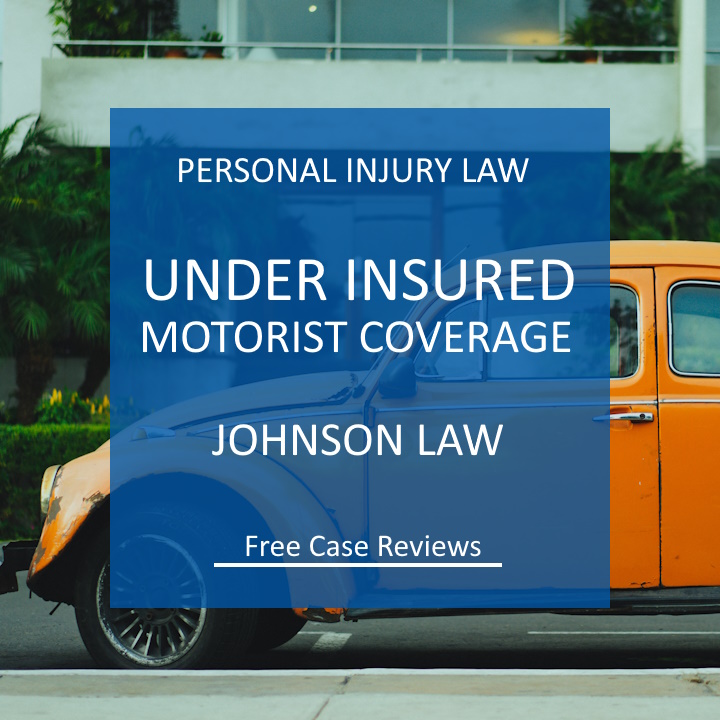What Is Underinsured Motorist Coverage?

Imagine you’re driving through Portland and another car runs a red light, crashing into you. You’re injured and your car is badly damaged. Later, you find out the at-fault driver only has Oregon’s minimum insurance – not nearly enough to cover all your medical bills, lost wages, and car repairs. What now? This is exactly the type of situation that underinsured motorist (UIM) coverage is designed for. In this article, we’ll explain what UIM coverage is, how it works in Oregon, and why it’s so important to protect yourself from underinsured drivers.
Understanding Underinsured Motorist (UIM) Coverage
Underinsured motorist coverage is a part of your auto insurance policy that protects you if you’re in an accident and the at-fault driver doesn’t have enough insurance to pay for your losses. In other words, it covers the “gap” between what the at-fault driver’s insurance can pay and the actual cost of your injuries and damages, up to the limits of your own UIM policy. UIM coverage typically applies to bodily injury – things like your medical expenses, lost wages, and pain and suffering – if the other driver’s liability insurance is insufficient. (Property damage from an uninsured driver is usually handled by other coverage, which we’ll note later.)
How is UIM different from Uninsured Motorist (UM) coverage? They are closely related protections, and in Oregon they are usually combined in one UM/UIM coverage on your policy. The difference comes down to the other driver’s insurance status:
- Uninsured Motorist (UM) Coverage: This covers you if the at-fault driver has no insurance at all (or in a hit-and-run where the driver can’t be identified). In that case, your own insurer steps in to pay for your injuries as if they were the missing insurance company.
- Underinsured Motorist (UIM) Coverage: This covers you if the at-fault driver has some insurance but not enough to cover all your damages. Your policy will pay the remaining amount of your losses that exceed the other driver’s policy limits, up to your UIM limit.
In practical terms, UM and UIM coverage kick in when you’re in a crash with someone who either isn’t insured or doesn’t carry enough insurance to cover your injuries. Both are about making sure you don’t end up paying the price for someone else’s lack of sufficient insurance.
Why Underinsured Motorist Coverage Matters (Especially in Oregon)
Even though Oregon requires every driver to carry liability insurance, many drivers on the road are uninsured or underinsured. In fact, Oregon has an estimated one in ten drivers without any insurance. On top of that, a large number of people only carry the bare minimum liability limits required by law – which often isn’t enough in a serious accident.
In Oregon, many drivers have little or no insurance coverage, which puts others at risk. As the graphic above illustrates, approximately 9–11% of Oregon motorists are uninsured, and around 20–25% only carry the minimum insurance required, leaving roughly one-third of drivers with no or minimal coverage. With so many underinsured drivers on the road, it’s easy to see why having UIM coverage is essential for your financial protection.
Consider the costs involved in a bad crash. Medical care is expensive – the average cost of a bodily-injury car accident claim exceeds $126,000. Yet Oregon’s minimum liability insurance is only $25,000 per person (and $50,000 per accident) for bodily injury coverage. It doesn’t take a math genius to spot the problem: if you’re seriously hurt, a minimal $25,000 policy from the at-fault driver will barely make a dent in your hospital bills. Underinsured motorist coverage is the safety net that catches you in this scenario. It steps in to pay the amount above the other driver’s policy limit, up to your UIM policy limit, so you’re not left footing the remainder of the bill.
Equally important, most drivers who carry low insurance limits don’t have substantial assets or cash to cover your damages out-of-pocket. If someone with minimal insurance hits you, it’s unlikely they can personally pay for your medical bills once their insurance is maxed out. Yes, you could sue them, but winning a judgment is one thing – actually collecting the money is another. Often, your own UIM coverage is the only realistic path to full compensation in these cases. It protects you from the financial fallout of an underinsured (or uninsured) driver’s mistake.
How UIM Coverage Works in Oregon
Oregon has specific laws governing uninsured/underinsured motorist coverage, and the good news is that the state looks out for drivers on this front. Here are key points about how UIM coverage works in Oregon:
- Mandatory Coverage and Minimum Limits: Unlike some states where you can reject UM/UIM coverage, Oregon law requires every auto insurance policy to include uninsured/underinsured motorist coverage. The minimum UIM coverage limits are $25,000 per person and $50,000 per accident for bodily injury. (These numbers mirror the state’s minimum liability coverage limits.) This means if you buy car insurance in Oregon, you automatically get at least $25k/$50k of UM/UIM coverage – it’s built into your policy by law. In practice, many drivers opt for higher limits to better protect themselves; your insurer will typically offer UM/UIM coverage equal to your liability coverage limits, unless you specifically choose lower limits in writing.
- What UIM Coverage Pays For: Oregon’s UM/UIM coverage is there to cover bodily injury losses – for you, your passengers, or any covered persons in your vehicle. That includes medical expenses, rehabilitation costs, lost wages, pain and suffering, and other damages resulting from injuries caused by an uninsured or underinsured driver. For example, if you miss work for several months due to injury, your UIM coverage can compensate your lost income just as the at-fault driver’s liability insurance would (had it been sufficient). Note: This coverage does not automatically cover damage to your vehicle; property damage claims are handled separately. If an uninsured driver wrecks your car, you would typically rely on your collision coverage or an optional uninsured motorist property damage (UMPD) coverage, since Oregon’s mandatory UIM applies to bodily injury only.
- “Stacking” and Oregon’s Pro-Consumer Rule: In Oregon, UIM coverage is “stackable” on top of the at-fault driver’s liability coverage, thanks to a law change in 2016. This is very important for maximizing your recovery. Stacking means that your UIM limit is in addition to whatever the other driver’s insurance pays – not reduced by it. For instance, if the other driver has $25,000 in liability coverage and you have $100,000 in UIM coverage, you could potentially access a total of $125,000 to cover your injuries (their $25k plus your $100k). Prior to 2016, Oregon insurers could subtract the at-fault driver’s payment from your UIM limit (so your $100k UIM would only pay $75k extra in that example), but the current law forbids such “anti-stacking” clauses. The result: Oregon drivers get the full benefit of the UIM coverage they’ve paid for. If your damages are high, every dollar counts, and this rule ensures more money is available to you up to the combined limits of both policies.
- Making a UIM Claim – The Process: Using your underinsured motorist coverage isn’t automatic; there’s a process to follow after an accident. First, you will pursue a claim against the at-fault driver’s insurance, just as you normally would in any accident. Your UIM coverage typically only comes into play after you have “exhausted” the at-fault driver’s liability insurance. In practical terms, this means you should recover the maximum from the other driver’s policy (for example, they pay their full $25,000 limit) or otherwise establish that their insurance is inadequate to cover your losses, before turning to your own insurer for UIM benefits. Once it’s clear that there’s a shortfall, you can file a UIM claim with your insurer for the remaining damages up to your UIM policy limit.It’s important to note that a UIM claim is made against your own insurance policy, but that doesn’t always mean it’s easy money. In fact, these claims can sometimes become complicated. You will need to prove the extent of your damages (just as you would in any insurance claim), and you still must establish that the other driver was at fault. Your insurance company may investigate the claim and even sometimes dispute aspects of it – remember, from their perspective, paying a large UIM claim is no different than any other payout. In Oregon, if there is a serious disagreement about the value of your claim or the circumstances, you have the right to take your own insurer to court or arbitration over the UIM payout, essentially placing your insurer in the shoes of the at-fault driver to resolve the claim. The good news is that Oregon’s consumer-friendly UIM laws (like the stacking rule above) give you a fair shot at recovery, but you should still be prepared to document your losses and negotiate as needed.
- UIM and Settlement: Often, an underinsured motorist claim will be resolved by settlement. For example, suppose the at-fault driver’s insurer pays their $25,000 limit, but your losses total $50,000. You would then make a claim for the remaining $25,000 under your UIM coverage. Your insurer might agree and pay that difference. However, if there’s a dispute (say your insurer believes your injuries aren’t worth the full $50k), they might offer a lower amount. This is where having evidence of your medical treatment, bills, and other damages is crucial. It’s also where you might consider getting legal advice – insurers, even your own, may try to minimize payouts, so it’s important to advocate for yourself to get the full benefit of your coverage.
In summary, Oregon’s system is set up so that every driver has at least some UIM protection by default, and the law allows you to combine insurance resources to cover your losses as much as possible. But you still need to understand your policy limits and ensure they’re high enough for your needs. $25,000 might be the legal minimum, but as we’ve seen, that may be woefully low in a serious accident. Many drivers opt for higher UM/UIM limits (such as $50,000, $100,000, or more) for added peace of mind. Increasing these limits will raise your premium slightly, but it could be a financial lifesaver if you’re ever hit by an underinsured driver. It’s worth reviewing your policy and considering whether the default limits would truly protect your family in a worst-case scenario.
Examples: When Would UIM Coverage Help You?
To make all of this more concrete, let’s look at a couple of realistic scenarios where underinsured motorist coverage would come into play. These examples illustrate how UIM coverage can make a huge difference after an accident:
- Severe Injuries, Minimal Insurance: You’re driving on I-5 near Portland when another driver swerves into your lane and causes a serious crash. You suffer a broken leg and a concussion, racking up $50,000 in hospital and rehab bills, plus several weeks of missed work. The at-fault driver carries only Oregon’s minimum $25,000 per person liability insurance. Their insurer pays you $25,000 (the maximum under their policy). This leaves $25,000 of your expenses uncovered. Fortunately, you have UIM coverage with a $50,000 limit. You file a claim with your insurer, and your UIM policy covers the remaining $25,000, making you whole (up to your policy limit). Without UIM, you would have been on the hook for that $25k shortfall or forced to sue the at-fault driver for the rest – who, as is common, has no assets to pay a judgment. UIM coverage saved you from a major financial hit.
- Multiple Victims, Limited Payout: You’re T-boned at an intersection by a driver who ran a stop sign. You have passengers in your car, and everyone sustains injuries. The at-fault driver has a liability policy of $50,000 per accident (the minimum for multiple victims in Oregon). That $50,000 is the total available to cover all injuries in the crash. If three people were hurt, for example, that money might be split three ways – perhaps each person gets only around $16,000, which may not cover even one ER visit and follow-up care. In this scenario, each of you can turn to your own UIM coverage. Because UIM is per person, each injured victim with UIM coverage can make a claim under their own policy to recover their remaining losses once the at-fault driver’s $50k is used up. So if your damages were $30,000 and you only got $16,000 from the other driver’s policy, your UIM can compensate the additional $14,000 (up to your limit). This way, each person isn’t limited by that shared $50k pot – everyone can access coverage for their full damages through their respective UIM policies. It can truly be a lifesaver in multi-victim accidents.
These scenarios show how underinsured motorist coverage steps in when other drivers’ insurance falls short. It’s worth noting that UIM coverage also typically covers you as a pedestrian or bicyclist if you’re hit by an underinsured (or uninsured) driver, and even if you’re a passenger in someone else’s car. In Oregon, your own auto policy’s UIM protection follows you in these situations, which can be crucial if you’re vulnerable on foot or on a bike and a driver injures you with insufficient insurance.
Protect Yourself from Underinsured Drivers
Underinsured motorist coverage may not be the first thing that comes to mind when you think about car insurance, but it is a vital protection for anyone on Oregon’s roads. Too many people drive with no insurance or minimal coverage, and that trend isn’t likely to disappear overnight. UIM coverage makes sure that you and your loved ones aren’t left holding the bag for someone else’s negligence. It provides an extra layer of security that can mean the difference between a full recovery and financial ruin after a serious accident.
What should you do now? First, review your auto insurance policy and check your UM/UIM coverage limits. Don’t assume you have plenty of coverage – verify the numbers. If you find your limits are low (e.g. the minimum 25/50) or you’re not comfortable they’d cover a bad crash, consider increasing them. The cost is usually reasonable, and the protection is well worth it. Talk to your insurance agent if you have questions about how much coverage you have or what it would cost to raise it.
Finally, if you’ve been in an accident with an uninsured or underinsured driver and you’re struggling to get full compensation, consider speaking with a qualified personal injury attorney. An attorney who understands Oregon’s insurance laws can help navigate the UIM claim process and advocate for the maximum compensation you’re entitled to under your policy. Remember, even your own insurer might resist paying a large claim – having experienced guidance can ensure you don’t settle for less than you need. While we hope you never need to use your UIM coverage, knowing it’s there – and understanding it – can give you peace of mind every time you hit the road. Stay safe out there, and drive protected!
Sources:
- Oregon DMV, Minimum Insurance Requirements (confirming Oregon’s 25/50/20 liability minimums and required UM/UIM coverage).
- Insurance Research Council via NW Insurance Council, Uninsured Drivers (2019 data showing ~10.7% of Oregon drivers uninsured).

